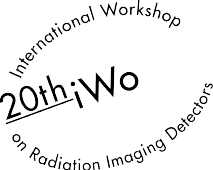Speaker
Description
Characterization of noise and quantum efficiency of the Pixirad-1/Pixie-III CdTe X-ray imaging detector
V. Di Trapani a, F. Brun b , D. Dreossi c, R. Longo d, L. Rigon d, P. Delogu a
aDipartimento di Scienze Fisiche, della Terra e dell’Ambiente, Università di Siena and INFN sez. di Pisa, Italy
bINFN, sez. di Trieste, Italy
cElettra-Sincrotrone Trieste S.C.p.A, Basovizza, Trieste, Italy
dDipartimento di Fisica, Università di Trieste and INFN, sez. di Trieste, Italy
In this work we present a study of the noise and quantum efficiency of a Pixirad detection system based on a CdTe Schottky sensor and PIXIE-III readout system [1]. In particular we compare the Signal to Noise Ratio (SNR) and the detective quantum efficiency (DQE) in different operation modes, when considering monochromatic radiation.
The Pixirad imaging system (PANalitycal) is based on a hybrid architecture were the sensor is bonded to the readout electronics. This system has square pixels with 62 μm pitch arranged in a matrix of 512×402 elements, thus covering an area of 31.7×25.0 mm2.
The sensor is made of CdTe with a thickness of 650 μm. Due to the high thickness-to-pixel pitch ratio, charge sharing between adjacent pixels is present. This effect can degrade both spatial and energy resolution [2] [3]. Another issue of this crystal is the production of fluorescence photons when high energy photons (above Cd or Te K-shells) are employed.
The readout implements, at single pixel level, two 15 bit counters fed by two independently settable energy discriminators. Moreover the chip can be configured in three different operation modes:
1. Pixel Mode (PM): each pixel counts independently from the others.
2. Neighbor Pixel Inhibit mode (NPI): only one pixel per event is allowed to count.
3. Neighbor Pixel Inhibit and Pixel Summing Mode (NPISUM): the signals of 4 neighbor pixels are summed together to correctly evaluate the total energy of any event involving up to 4 pixels; only one pixel per event is allowed to count.
For a monochromatic X-ray beam of energy E below Cd K-shell (26.7 KeV), and threshold below E/2, almost all the interacting photons are registered. In PM mode multiple counts from a single interacting photon can be registered, and the number of counts can exceed the number of interacting photons. Moreover multiple counts induce statistical correlation between adjacent pixels reducing the noise and increasing the SNR. In NPI and NPISUM modes multiple counts are avoided and the number of counts correspond to the number of interacting photons.
For threshold above E/2, in PM and NPI modes some events may be not recorded, thus decreasing the SNR and the detection efficiency. On the other hand, in NPISUM mode all the interacting photons are recorded.
For photons of energy above Cd k-shell, fluorescence photons can interact far from the point in which the primary interaction occurs. In this case, if the threshold is not set to a sufficiently high value, all the considered acquisition modes can register multiple counts due to both the primary interacting photon and the fluorescence photon.
To quantify this behavior, we used monochromatic synchrotron radiation of two different energies (26 KeV and 33 KeV), below and above the K-shells of the sensor material.
In particular we acquired sets of images of the beam at SYRMEP beamline (Elettra, Trieste) in all the different operating modes and varying the discriminator threshold. On these images we measured the SNR, compared it to the pure Poisson case and finally calculated the DQE. Results are in good agreement with the expected behavior and a constant SNR is observed in NPISUM without dependence by the threshold values. This feature candidates the NPISUM mode as the best choice in spectral imaging with polychromatic beam.
References
[1] R. Bellazzini et al., 'Pixie-III: a very large area photon-counting CMOS pixel ASIC for sharp X-ray spectral imaging', JINST 10 C01032 (2015)
[2] P. Delogu et al., 'Characterization of Pixirad-1 photon counting detector for X-ray imaging' JINST 11 P01015 (2016 )
[3] A. Vincenzi, P.L. de Ruvo, P. Delogu et al., ' Energy characterization of Pixirad-1 photon counting detector system', JINST 10 C04010 (2015)
